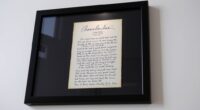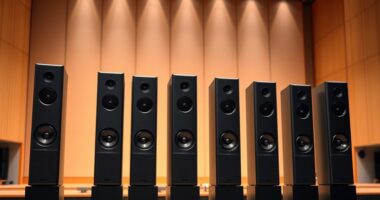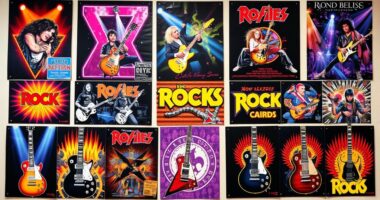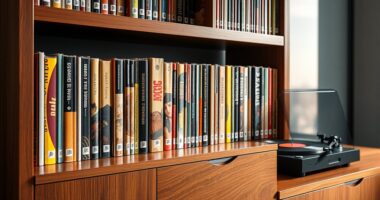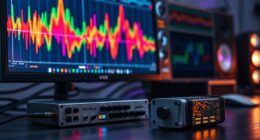If you’re looking for the best studio monitor calibration mics, I recommend considering options like the Audyssey ACM1-X for precise room calibration, the Sony ECM-AC2 for easy setup, and versatile units like the Superlux ECM999. Other popular choices include calibration tools like Calibrite CCSTUDIO and specialized isolation shields for cleaner measurements. To find the perfect fit for your setup, you’ll want to weigh compatibility, build quality, and calibration accuracy—keep exploring for all the details.
Key Takeaways
- Look for calibration microphones with flat frequency response and high SPL handling for accurate room measurement.
- Opt for models compatible with popular calibration software like MultEQ-X, XT, or XT32.
- Prioritize durable, portable designs with adjustable stands or wall-mount options for flexible setup.
- Consider microphones with individual calibration files for precise acoustic analysis.
- Choose well-reviewed brands like Audyssey and Sony for reliable performance and broad system compatibility.
Superlux ECM999 Measurement Microphone (Omnidirectional Condenser)
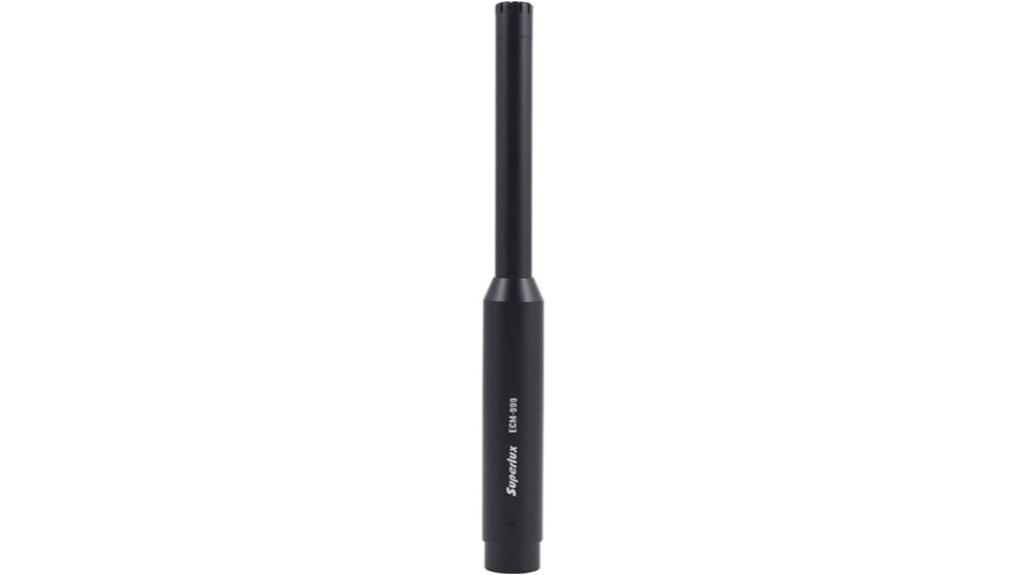
If you’re looking for an affordable yet reliable microphone for room calibration and acoustic testing, the Superlux ECM999 is an excellent choice. Its omnidirectional condenser capsule captures sound accurately from all directions, making it ideal for precise room analysis. With a flat frequency response from 20Hz to 20kHz, it ensures true sonic reproduction for calibration tasks. It handles high sound pressure levels up to 132dB SPL, perfect for both quiet and loud environments. Compatible with various audio interfaces and powered via phantom power, it’s versatile and easy to integrate into your setup. Its solid build, included accessories, and affordability make it a popular choice among professionals and hobbyists alike.
Best For: professionals and hobbyists seeking an affordable, accurate omnidirectional measurement microphone for room calibration, acoustic testing, and sound analysis.
Pros:
- Flat frequency response from 20Hz to 20kHz ensures precise sonic reproduction
- Handles high sound pressure levels up to 132dB SPL, suitable for diverse environments
- Solid build quality with included accessories makes it portable and easy to set up
Cons:
- Requires phantom power (12V–52V) for operation, which may not be available on all equipment
- No individual calibration files, so some users may need external calibration for ultra-precise measurements
- Slightly larger and heavier than some handheld microphones, which might affect portability for some users
Audyssey Replacement Calibration Microphone for AVRs
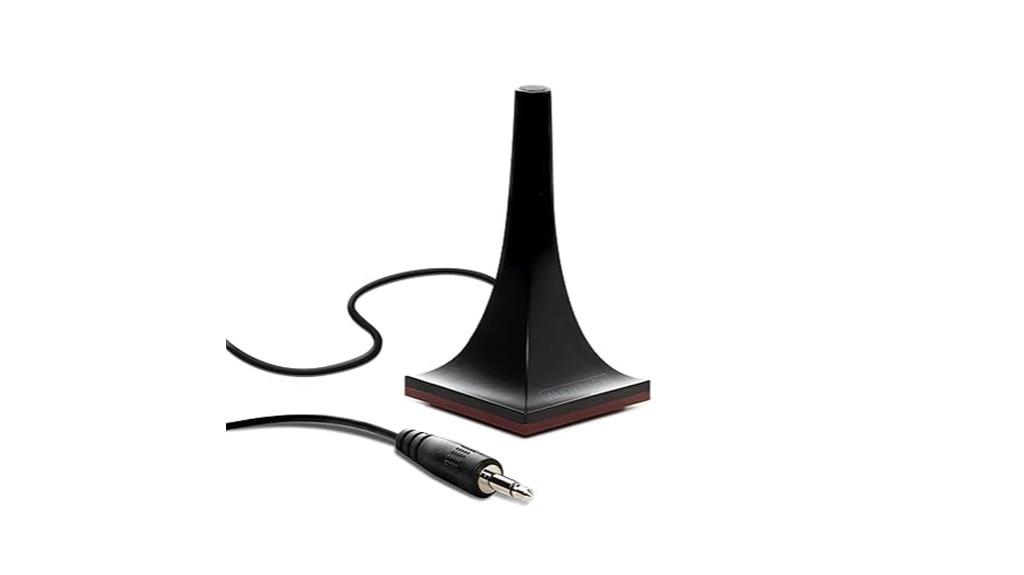
The Audyssey Replacement Calibration Microphone for AVRs is an ideal choice for users with compatible Denon, Marantz, Onkyo, Integra, Teac, or Tascam AV receivers who want to restore or enhance their system’s calibration accuracy. This genuine Audyssey mic captures sound omnidirectionally, ensuring precise room measurements for *superior* speaker performance. It works seamlessly with Audyssey’s MultEQ, MultEQ XT, and XT32 software, following the specific instructions for supported AVRs. Produced by Audyssey, it’s a reliable, research-backed solution designed solely for calibration purposes. Keep in mind, it’s only compatible with certain models, so check your receiver before purchasing.
Best For: users with compatible Denon, Marantz, Onkyo, Integra, Teac, or Tascam AV receivers seeking to restore or improve their calibration accuracy.
Pros:
- Genuine Audyssey product ensuring reliable calibration performance
- Omnidirectional design captures sound from all directions for precise room measurement
- Compatible with multiple Audyssey software variants (MultEQ, XT, XT32) for versatile use
Cons:
- Limited to specific AVR models; not suitable for general microphone applications
- Only intended for calibration purposes, not for other audio recording or measurement uses
- Requires supported AV receiver models; incompatible with unsupported or unlisted systems
Audyssey ACM1-X Microphone for AV Receivers
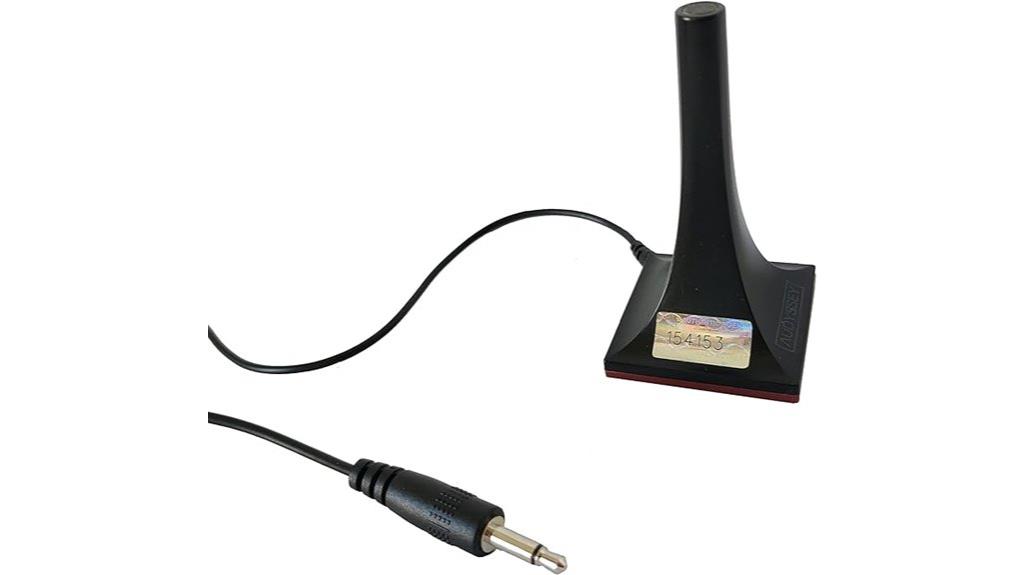
Designed for audio enthusiasts and professionals, the Audyssey ACM1-X Microphone delivers unmatched measurement precision for room correction in home theater systems. This individually calibrated, omnidirectional mic is compatible with the MultEQ-X app on Windows 10 and 11, ensuring highly accurate calibration when paired correctly. Each unit undergoes calibration at Audyssey’s Los Angeles lab, generating a unique file for ideal performance. While the microphone doesn’t work directly with AVR built-in tools, pairing it with the $199 MultEQ-X software considerably improves sound clarity, imaging, and bass response. Many users report that this setup creates a more balanced, immersive listening experience.
Best For: audio enthusiasts and professionals seeking professional-grade room calibration to optimize their home theater sound quality.
Pros:
- Provides highly accurate, individually calibrated measurements for precise room correction
- Significantly improves sound clarity, imaging, and bass response compared to uncalibrated setups
- Compatible exclusively with the MultEQ-X app on Windows 10 and 11, enabling advanced calibration control
Cons:
- Requires the additional purchase of the $199 MultEQ-X software for optimal use
- Not compatible with AVR built-in calibration tools or mobile apps; limited to Windows 10/11
- The calibration files are generated after professional analysis; the microphone alone does not include preloaded calibration data
Calibrite ColorChecker Studio (CCSTUDIO)
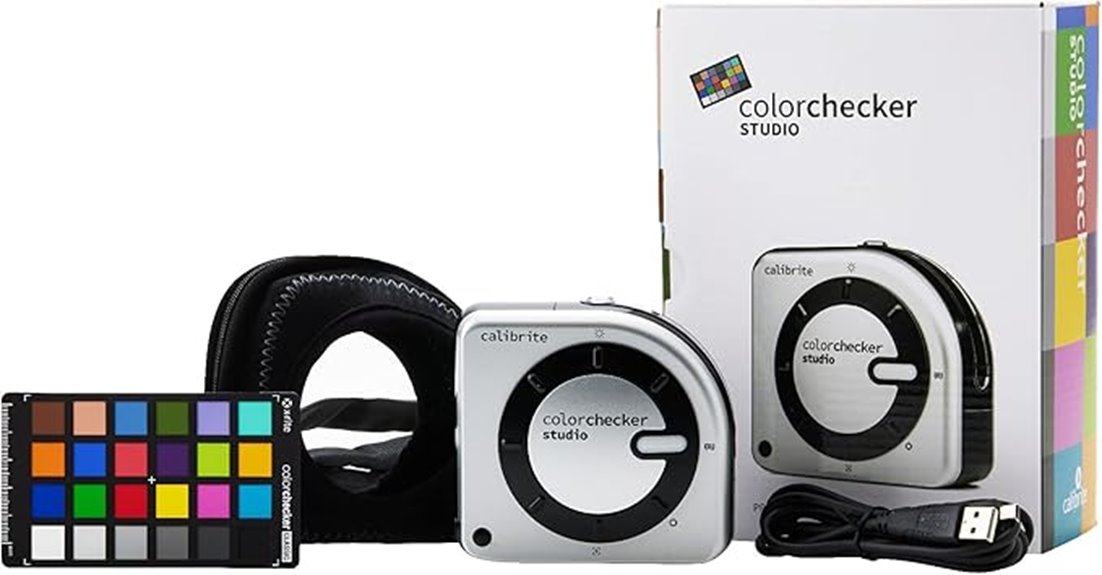
Calibrite ColorChecker Studio (CCSTUDIO) stands out as a versatile calibration tool for photographers and digital artists seeking accurate color profiles across multiple devices. It supports monitor, projector, scanner, printer, and camera profiling, offering thorough color management with its ccStudio software. Features like Intelligent Iterative Profiling optimize color accuracy, while ambient light measurement helps determine ideal luminance. However, users often face compatibility issues, especially with newer hardware and OS versions, and find the setup process confusing due to limited documentation. Despite these challenges, when properly calibrated, CCSTUDIO delivers accurate, natural colors that enhance print and digital display fidelity.
Best For: photographers, digital artists, and print professionals seeking comprehensive color calibration across multiple devices despite potential setup challenges.
Pros:
- Supports a wide range of devices including monitors, printers, projectors, scanners, and cameras for versatile calibration.
- Features like Intelligent Iterative Profiling and ambient light measurement enhance color accuracy and viewing conditions.
- Produces accurate, natural color profiles that improve print and digital display fidelity once properly set up.
Cons:
- Compatibility issues with modern hardware and OS versions, especially Windows 11 and newer Macs.
- Lack of detailed documentation and manual, making setup and troubleshooting confusing for users.
- Hardware reliability concerns, including physical design flaws and failure reports, complicate user experience.
New Sony Calibration Microphone ECM-AC2 with Part Numbers 154277421, 1-542-670-21, 154271011, 1-542-710-11, 154267021, 1-542-774-21
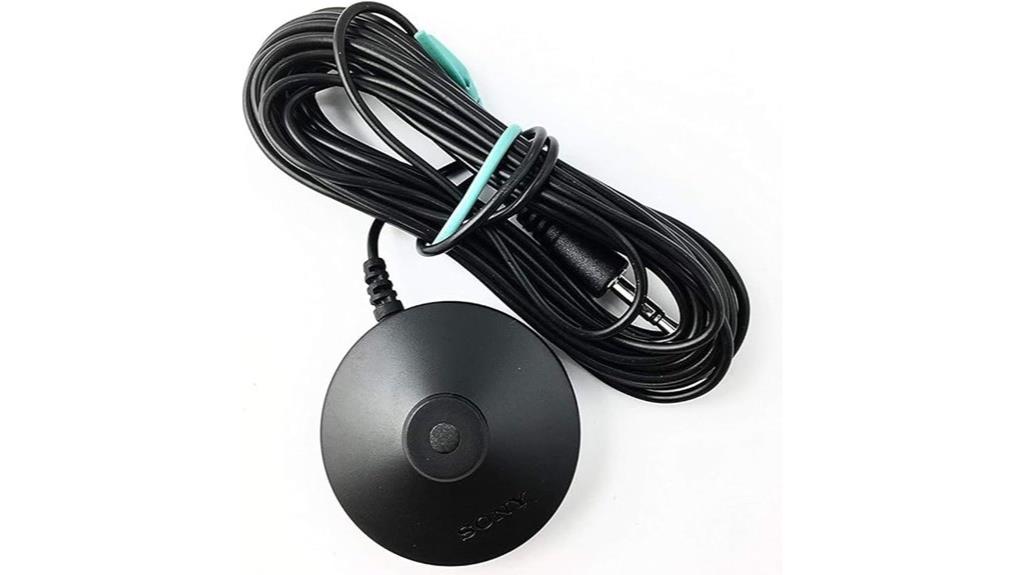
If you’re looking for a reliable calibration microphone that guarantees precise sound tuning, the Sony ECM-AC2 is an excellent choice, especially for home theater enthusiasts and audio professionals. With part numbers 154277421, 1-542-670-21, 154271011, 1-542-710-11, 154267021, and 1-542-774-21, it’s designed for Sony AV receivers and systems, compatible with around 150 models. Its straightforward setup, high signal-to-noise ratio of 75 dB, and compact, boundary form factor make calibration easy and accurate. Customers praise its reliability and effectiveness, noting significant improvements in sound quality after calibration. It’s a dependable tool for achieving balanced, ideal audio performance.
Best For: home theater enthusiasts and audio professionals seeking precise, reliable speaker calibration for Sony AV systems.
Pros:
- Easy plug-and-play setup with straightforward calibration process
- Compatible with approximately 150 Sony models, ensuring broad usability
- High signal-to-noise ratio of 75 dB for accurate sound measurements
Cons:
- Requires proper connection and placement to avoid calibration errors
- Thin wire may be prone to tripping or misplacement without bright color options
- Limited to Sony systems, reducing versatility with non-Sony equipment
HCDZ Calibration Microphone for Home AV Receivers
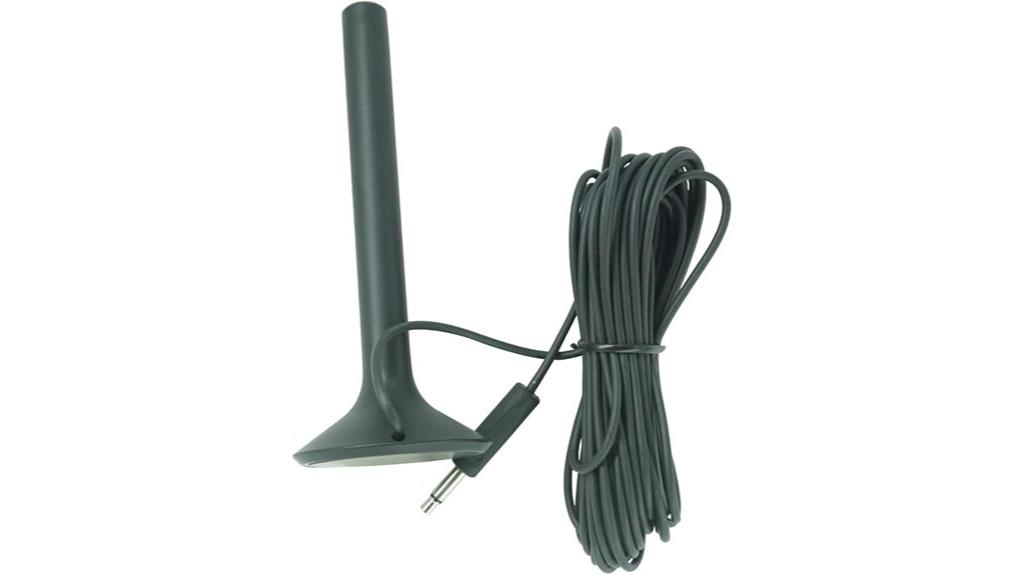
The HCDZ Calibration Microphone stands out as an excellent choice for home theater enthusiasts seeking precise audio calibration. It’s a professional-grade device compatible with leading brands like Onkyo, Denon, Marantz, Yamaha, Pioneer, and Sony, ensuring accurate sound adjustments. Its durable construction and lightweight design make setup straightforward—just plug it into your receiver and position it properly at ear level. With a signal-to-noise ratio of 75 dB, it provides reliable, clear measurements for ideal audio performance. Rated highly by users, this microphone offers a simple, effective solution for achieving immersive, balanced sound in your home theater system.
Best For: Home theater enthusiasts and audiophiles seeking precise and reliable audio calibration for their AV receivers.
Pros:
- Compatible with top brands like Onkyo, Denon, Marantz, Yamaha, Pioneer, and Sony for versatile use
- Durable construction with lightweight, compact design for easy setup and portability
- Provides clear, accurate measurements with a high signal-to-noise ratio of 75 dB
Cons:
- Requires proper positioning and secure connection for optimal calibration results
- Operates on corded power, which may limit placement flexibility
- Only rated 4.5 out of 5 stars based on a small number of customer reviews
Upgraded Studio Recording Microphone with Isolation Shield & Pop Filter
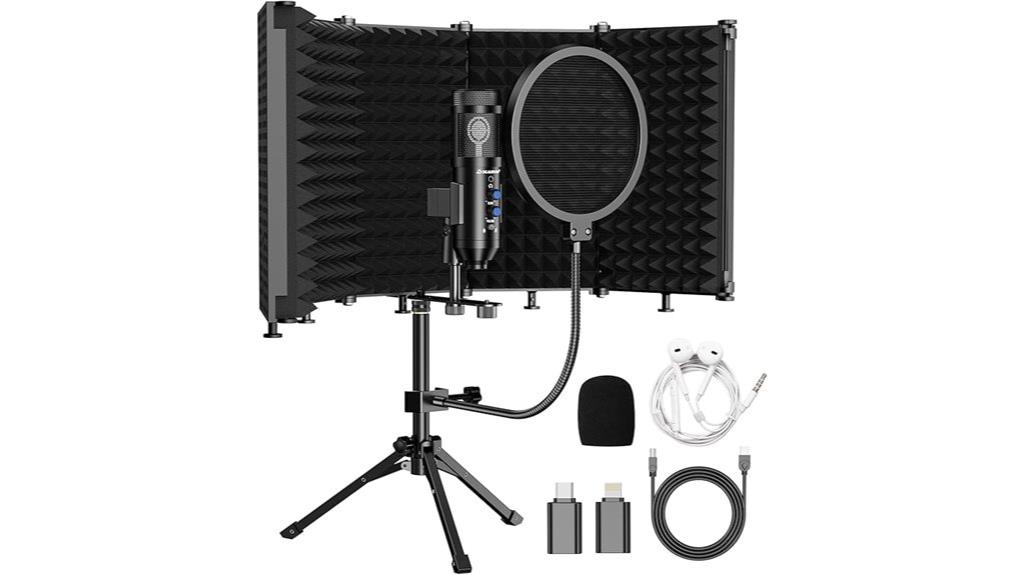
This upgraded studio recording microphone with an isolation shield and pop filter is perfect for content creators who want professional-quality sound with minimal background noise. It features a USB output for easy plug-and-play use with PCs, smartphones, or laptops, making setup straightforward. The cardioid polar pattern focuses on your voice while reducing ambient noise, thanks to the foldable, high-density sound-absorbing panels. The kit includes a pop filter, shockproof filter, and adjustable isolation shield, all lightweight and portable. With 16mm diaphragm, wide frequency response, and support for multiple device adapters, it’s ideal for podcasting, vocals, streaming, and music production.
Best For: content creators, podcasters, streamers, and musicians seeking professional-quality sound with minimal background noise and easy setup.
Pros:
- Easy plug-and-play USB connection compatible with PC, smartphones, and laptops.
- Equipped with an adjustable isolation shield and sound-absorbing panels to reduce ambient noise.
- Comes with comprehensive accessories including pop filter, shockproof filter, and multiple adapters for versatile use.
Cons:
- Slightly larger setup may require dedicated space for optimal positioning.
- The foldable soundproof shield, while portable, may need careful handling to maintain durability.
- Some users may prefer higher-end audio interfaces for advanced recording needs.
IK Multimedia ARC Studio Room Correction System with High-Precision Microphone
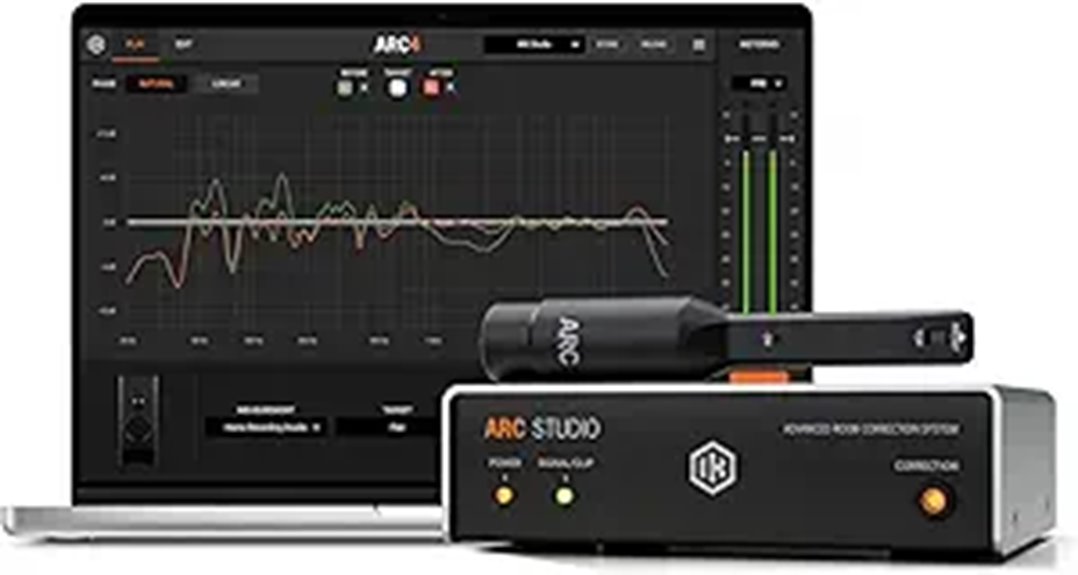
For audio engineers and serious producers seeking professional-level room correction, the IK Multimedia ARC Studio System stands out with its high-precision measurement microphone and advanced software. This professional-grade setup includes components designed to optimize your space’s acoustics, rectifying frequency imbalances and enhancing stereo imaging. It accurately emulates high-end monitors and reference systems, making it ideal for achieving studio-quality mixes with minimal acoustic treatment. The system’s user-friendly design allows seamless integration into various environments, including home studios and professional spaces. With its reliable, set-it-and-forget-it performance, the ARC Studio System ensures consistent, accurate sound—saving time and letting you focus on your creative process.
Best For: audio engineers and serious producers seeking professional-level room correction and precise acoustic optimization for studio-quality mixes.
Pros:
- Professional-grade components including high-precision measurement microphone and advanced correction software
- Effectively rectifies frequency imbalances and enhances stereo imaging for superior sound clarity
- Seamless integration and user-friendly design suitable for various environments, from home studios to professional spaces
Cons:
- May require initial setup and calibration time for optimal results
- Cost may be higher compared to basic room correction solutions
- Dependence on software and hardware compatibility could limit some user configurations
IK Multimedia iLoud Micro Monitor Pro (Pair) 50W Portable Studio Monitors
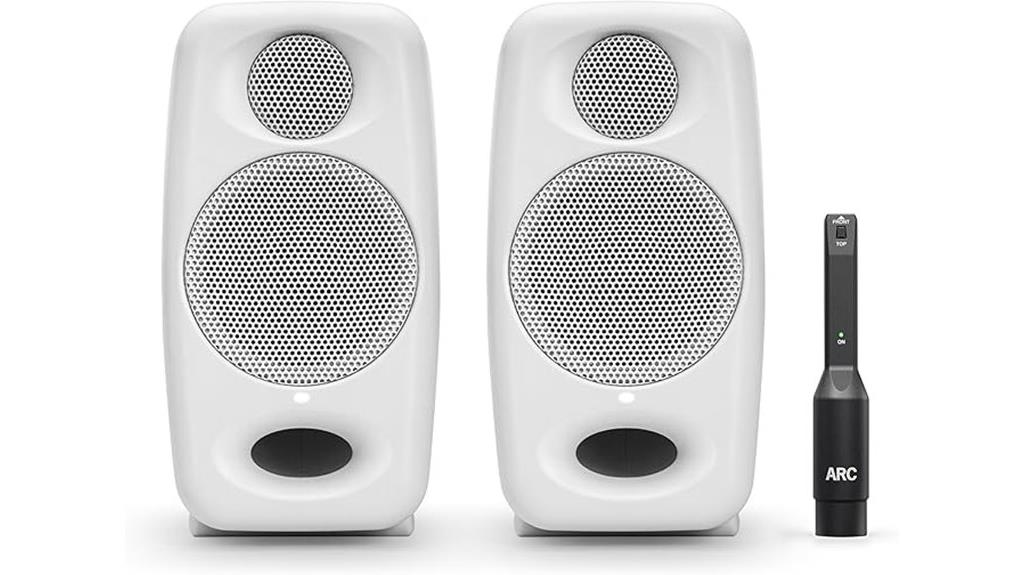
If you’re looking for portable studio monitors that deliver professional-grade sound on the go, the IK Multimedia iLoud Micro Monitor Pro (Pair) stands out with its built-in ARC calibration. These 50W monitors offer ultra-accurate, flat, and detailed sound ideal for music mixing, with bass extension down to 42 Hz and a max SPL of 95 dB. Their compact, lightweight design makes them backpack-friendly, and the integrated stand allows for quick setup anywhere. Powered by a high-efficiency Class D amplifier and custom drivers, they ensure precise audio reproduction. The built-in ARC calibration and included mic enable instant room tuning, making these monitors perfect for mobile professional use.
Best For: musicians, audio engineers, and mobile professionals seeking portable, high-quality studio monitors with precise sound and room calibration capabilities.
Pros:
- Ultra-accurate, flat, and detailed sound ideal for mixing
- Built-in ARC calibration with included mic for quick room tuning
- Compact, lightweight, and backpack-friendly design for portability
Cons:
- Limited bass extension down to 42 Hz may not satisfy all bass-focused applications
- Max SPL of 95 dB might be insufficient for very high-volume environments
- Premium price point could be a consideration for budget-conscious users
Calibration Microphone ECM-AC2 for Sony Receiver Models
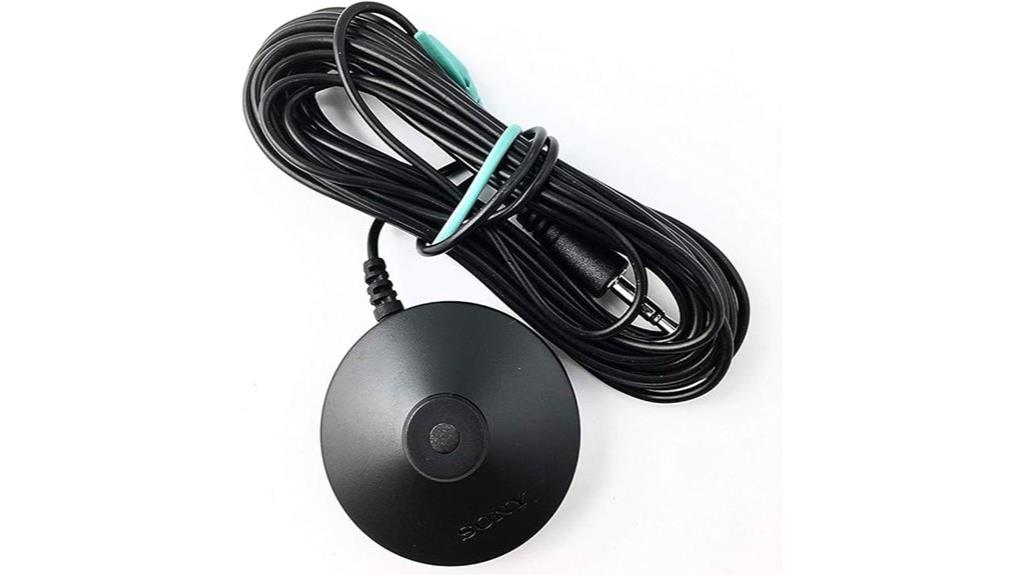
The Calibration Microphone ECM-AC2 stands out as an ideal choice for Sony home theater owners seeking precise room calibration. Compatible with around 150 Sony models, including STR-DG, STR-DH, and STR-DN series, it also works with brands like Pioneer, Onkyo, Marantz, and Samsung. This lightweight microphone features a high signal-to-noise ratio of 100 dB and an easy-to-use phone jack connection. Customers report improved sound quality and successful calibration, though some note durability issues after multiple uses. Priced around $30, it offers a cost-effective solution for fine-tuning your home theater system, ensuring excellent audio performance.
Best For: Home theater enthusiasts and Sony receiver owners seeking accurate calibration and improved audio performance on a budget.
Pros:
- Compatible with approximately 150 Sony models and other major brands like Pioneer and Onkyo
- Easy to connect via standard phone jack for straightforward calibration
- Notable improvements in sound quality and speaker setup accuracy
Cons:
- Some units may experience durability issues after multiple uses
- Slightly higher price point (~$30) for a calibration microphone
- Limited longevity concerns reported by users, affecting repeated calibration reliability
Moukey Microphone Isolation Shield with Tripod Stand
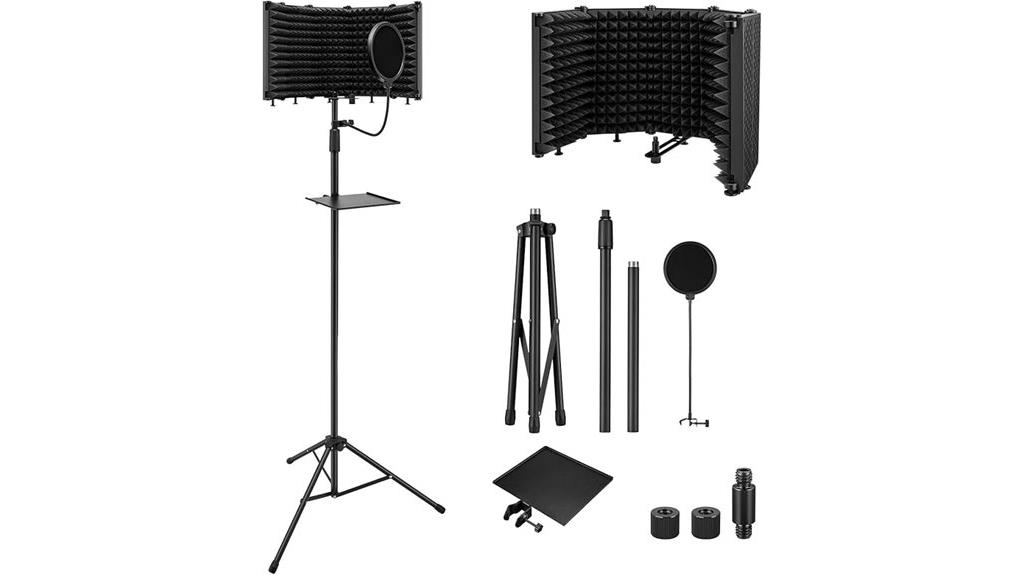
The Moukey Microphone Isolation Shield with Tripod Stand stands out as an excellent choice for podcasters and home studio creators seeking to improve sound clarity and reduce ambient noise. Its triple sound insulation—reflective, filter, and absorbing layers of high-density acoustic foam—minimizes audio bounce-back and interference. The foldable design with five adjustable panels makes setup quick and customizable. The stand is height-adjustable from 42 to 71.5 inches, supporting sitting or standing recordings. Made from durable materials, it ensures stability and safety, whether on a desk or mounted on a boom arm. This versatile setup helps capture clean, professional sound in any recording environment.
Best For: podcasters, home studio creators, and recording enthusiasts seeking to enhance sound clarity and minimize ambient noise during recordings.
Pros:
- Effective triple sound insulation with reflective, filter, and absorbing layers for clear audio.
- Foldable and adjustable design allows quick setup and customization for different recording needs.
- Stable, durable construction with a height-adjustable stand suitable for various environments.
Cons:
- May be bulky to transport due to its foldable panels and stand.
- Assembly and adjustments might require some time for optimal positioning.
- The acoustic foam, while effective, may need replacement or maintenance over time to maintain sound quality.
M-Audio BX4 Studio Monitors (Pair)
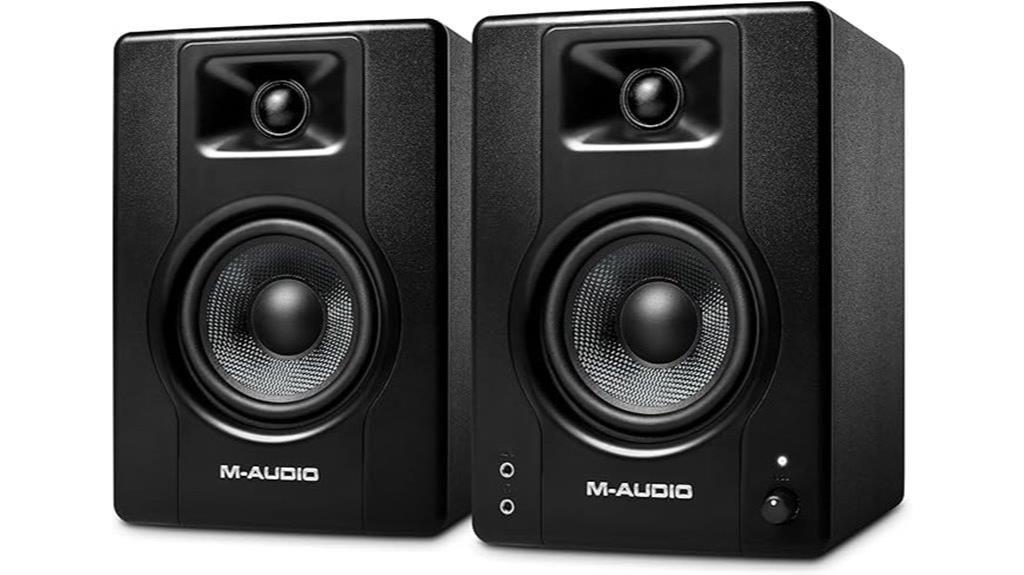
M-Audio BX4 Studio Monitors (Pair) stand out as an excellent choice for musicians, podcasters, and streamers who need accurate, studio-quality sound in a compact setup. These 120-watt powered monitors deliver deep, rich audio thanks to their MDF cabinet and bass reflex design. The 4.5” Kevlar low-frequency drivers and 1” silk dome tweeters produce high-fidelity sound with precise imaging, enhanced by a computer-optimized tweeter waveguide. With versatile connectivity options like 1/4”, 1/8”, and RCA inputs, they’re suitable for various applications, from music production to gaming. Plus, high and low EQ controls help tailor the sound to your environment.
Best For: musicians, podcasters, streamers, and audio enthusiasts seeking accurate, studio-quality sound in a compact, versatile setup.
Pros:
- Delivers powerful 120-watt sound with deep, rich bass and clear high frequencies
- Versatile connectivity options including 1/4”, 1/8”, and RCA inputs for various devices
- Equipped with high and low EQ controls to customize sound to your environment
Cons:
- May be larger than typical PC speakers for very limited space setups
- Requires an external power source, not USB-powered
- Slightly higher price point compared to basic computer speakers
Dmsky Microphone Isolation Shield with Pop Filter & Tripod Stand
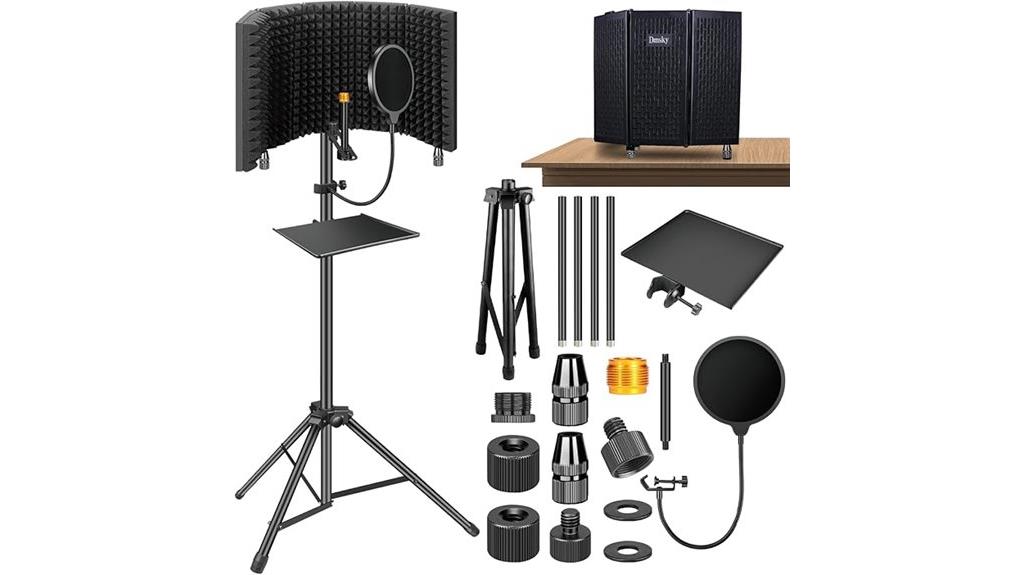
If you’re looking to improve your recording clarity, the Dmsky Microphone Isolation Shield with Pop Filter & Tripod Stand is an excellent choice, especially for home studio creators and podcasters. Its triple-layer sound insulation—reflective, filter, and absorbing—reduces external noise and minimizes audio bounce for cleaner sound. The foldable design with five adjustable panels offers customizable positioning, while the height range from 42 to 71.5 inches suits sitting or standing setups. Made from durable steel, the stand is stable and easy to assemble. Including a pop filter, adapters, and a storage tray, it’s a versatile, long-lasting solution to enhance your recording environment.
Best For: home studio creators, podcasters, and recording enthusiasts seeking improved sound quality and noise reduction.
Pros:
- Excellent triple-layer sound insulation reduces external noise and audio bounce for clearer recordings.
- Adjustable foldable panels and height range offer customizable and versatile setup options.
- Durable steel construction with a stable tripod base ensures long-lasting use and stability.
Cons:
- Slightly heavy at 8.38 pounds, which may make portability less convenient.
- Assembly requires some effort to adjust panels and support points for optimal positioning.
- The size and bulk may be challenging for very limited space environments.
Factors to Consider When Choosing Studio Monitor Calibration Mics
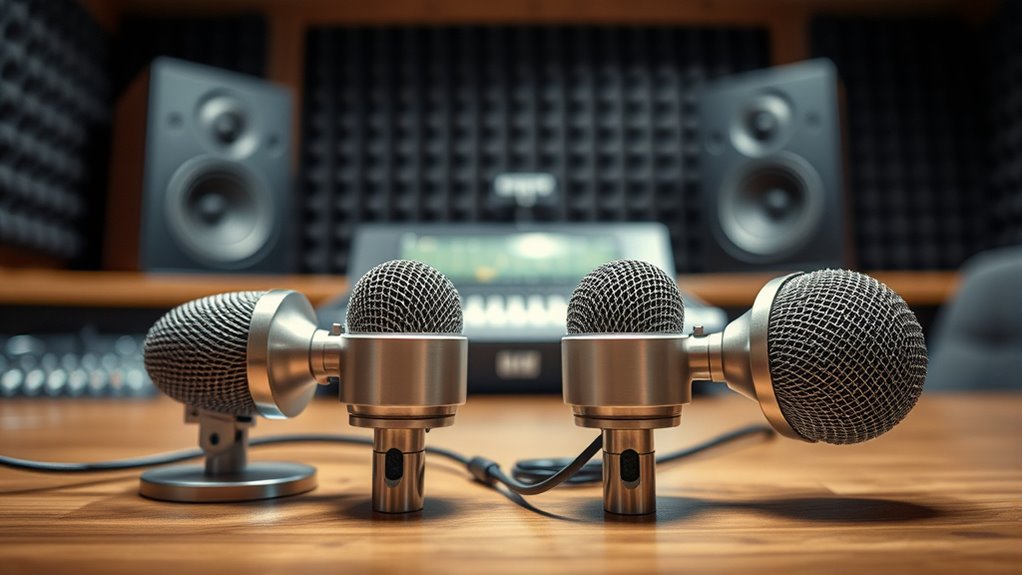
When choosing a studio monitor calibration mic, I consider how well it fits my existing equipment and the level of calibration accuracy I need. Build quality and ease of setup are also important to guarantee longevity and straightforward use. Ultimately, I look at calibration software features to make sure they enhance precision and workflow.
Compatibility With Equipment
Choosing the right calibration microphone requires guaranteeing it’s compatible with your existing equipment. First, check that the mic’s phantom power requirements match your audio interface or receiver, typically between 12V and 52V for condenser mics. It’s also vital to confirm the connector type—whether XLR or 3.5mm jack—so it fits seamlessly. Additionally, verify that the microphone’s impedance and signal-to-noise ratio align with your device’s specifications to guarantee accurate measurements. Compatibility with your measurement software, like Room EQ Wizard or proprietary tools, is essential for smooth operation. Finally, confirm the mic’s frequency response range covers your calibration needs, such as 20Hz to 20kHz, and works well within your audio processing setup. Proper compatibility guarantees reliable, consistent calibration results.
Calibration Accuracy Level
The accuracy of your calibration microphone directly impacts the quality of your monitoring system, making it vital to contemplate several key factors. A higher calibration accuracy level ensures a more precise correction of the frequency response, resulting in a flatter, more natural sound. Look for microphones with low Total Harmonic Distortion (THD) and minimal noise floors, as these improve measurement accuracy. An individually calibrated mic with a traceable calibration certificate provides verified precision and reduces measurement errors. Additionally, a microphone with flat frequency response across the entire audible spectrum (20Hz-20kHz) guarantees accurate calibration. Consistency over multiple uses is also essential; select microphones known for stable calibration performance to guarantee your setup remains reliable over time.
Build Quality and Durability
Durability is a crucial factor to contemplate because a calibration microphone needs to withstand regular handling and environmental factors without losing accuracy. I look for models built with sturdy materials like metal or reinforced plastics, ensuring they can handle daily use. A strong capsule and reliable connector design are essential to prevent damage from impacts or repeated connections. The microphone’s housing should be well-sealed and free of manufacturing defects that could compromise its lifespan. Additionally, features like strain relief on cables and secure mounting options help reduce wear over time. A durable calibration mic maintains consistent performance and accuracy even after extensive handling or exposure to challenging conditions. Investing in a well-built microphone ensures longevity and reliable calibration, which ultimately leads to better sound quality in my studio.
Ease of Setup
Ease of setup is a key factor because a calibration microphone should allow quick, straightforward installation to get your studio up and running without hassle. A user-friendly mic features clear, simple instructions that minimize confusion during setup, saving you time. Its physical design, with minimal components and intuitive controls, helps reduce initial assembly and connection efforts. Compatibility with common calibration software and systems further streamlines the process, preventing the need for complex configurations. Quick connection options like plug-and-play USB or standard audio jacks make setup faster, avoiding tangled wires or extra equipment. Additionally, detailed documentation or video tutorials can be invaluable, especially if you’re new to calibration. Overall, choosing a mic with easy setup ensures you spend less time on installation and more on achieving perfect sound.
Calibration Software Features
Choosing the right calibration software is essential because it directly impacts the accuracy and ease of fine-tuning your studio monitors. I look for software with advanced tools for precise frequency response analysis, like real-time graphing and detailed measurement metrics, which help me identify issues quickly. Customizable calibration profiles are a must, allowing me to apply correction curves tailored to my room. Compatibility with dedicated measurement microphones and the ability to import calibration files ensure my measurements are accurate. Features such as room correction, speaker delay adjustments, and EQ fine-tuning provide a *thorough* setup. An intuitive user interface with clear instructions, automation options, and troubleshooting support makes calibration straightforward, saving me time and ensuring consistent results.
Frequency Response Range
Have you ever considered how crucial a microphone’s frequency response range is when calibrating studio monitors? A wider range, typically from 20Hz to 20kHz, ensures the mic can accurately measure the full spectrum of sound. This allows for precise room and speaker calibration, minimizing measurement bias. Microphones with a flat and extended frequency response provide more reliable results, capturing both deep bass and sparkling treble. Matching the response to human hearing sensitivity helps create a natural, balanced sound. If the microphone’s frequency response is limited or uneven, calibration accuracy suffers, which can distort the stereo image and overall sound quality. Choosing a microphone with an appropriate, wide, and flat frequency response is essential for achieving accurate, professional-grade calibration.
Price and Cost Effectiveness
Selecting a calibration microphone that offers the best value for your investment depends on balancing cost with performance. Budget options around $30 may suffice for casual use, but their durability and consistency can be limited, possibly leading to extra costs over time. Higher-priced models over $500 often include individual calibration and superior accuracy, reducing the need for repeated measurements and adjustments, which can save money in the long run. The key is to guarantee the microphone’s calibration precision matches your audio quality goals. Comparing features such as frequency response flatness, noise levels, and software compatibility helps determine if the price reflects the microphone’s value and performance. Ultimately, choosing a mic that offers reliable calibration without unnecessary expenses ensures better long-term cost effectiveness.
Long-Term Reliability
Long-term reliability of studio monitor calibration microphones hinges on the use of durable construction materials that can withstand wear and environmental stress. I look for mics built with sturdy components that resist degradation over time, guaranteeing consistent performance. Stability of internal parts is also vital; they shouldn’t drift or degrade with frequent use. Reputable manufacturers often back their products with warranties and support, which provides peace of mind for repairs or replacements down the line. Proper handling and storage are essential—protecting the mic from damage preserves its accuracy. Additionally, regular calibration checks and maintenance help keep the microphone performing at its best throughout its lifespan. Prioritizing these factors ensures that my calibration mic remains reliable and precise over the long haul.
Frequently Asked Questions
How Does Microphone Placement Affect Calibration Accuracy?
Microphone placement directly impacts calibration accuracy because it determines how well the mic captures the room’s acoustics. If placed too close or in the wrong spot, it can pick up unwanted reflections or noise, skewing results. I always position my mic at ear level and equidistant from the monitors, ensuring it captures a true representation of the sound. Proper placement helps me achieve a more precise and balanced calibration.
Can Calibration Mics Be Used for Live Sound Setups?
Absolutely, calibration mics can be used for live sound setups, but they’re primarily designed for studio environments. Think of them as a master key—helpful, but not always perfect for every lock. In live settings, factors like ambient noise and room acoustics complicate things. While they can improve your sound, you’d typically need specialized equipment and experience to get the best results, especially in dynamic, unpredictable venues.
What Maintenance Is Required for Calibration Microphones?
To keep calibration microphones in top shape, I regularly clean the capsule with a soft, dry cloth and store them in a protective case to prevent dust and damage. I also avoid extreme temperatures and humidity, which can affect accuracy. Periodically, I check their calibration against a known sound source and replace any damaged or worn components. Proper maintenance guarantees consistent, reliable measurements for perfect sound calibration.
Are Calibration Microphones Compatible With All Studio Monitors?
Think of calibration microphones as universal keys—they’re designed to fit most studio monitors, but not all. While many models are compatible, some monitors with unique designs or proprietary systems might require specific mics. I recommend checking your monitor’s specifications before purchasing. Like a well-fitted suit, the right calibration mic guarantees sound accuracy, so compatibility is crucial to achieving that perfect, balanced mix you’re after.
How Often Should Calibration Microphones Be Recalibrated?
I recommend recalibrating your microphone at least once every six months, especially if you notice changes in sound quality or after significant equipment upgrades. Regular recalibration ensures your measurements stay accurate, maintaining ideal sound quality. If you work in a highly dynamic environment or frequently move your setup, consider more frequent recalibrations, like quarterly, to keep your studio sound precise and consistent.
Conclusion
In the end, choosing the right calibration mic is key to achieving perfect sound. Remember, “you get what you pay for,” so investing in quality guarantees accurate tuning and better listening experiences. Whether you opt for a superlux measurement mic or a trusted AV receiver mic, it’s all about matching your needs. Take your time, do your research, and sound clarity will follow—because when it comes to audio, precision makes all the difference.

